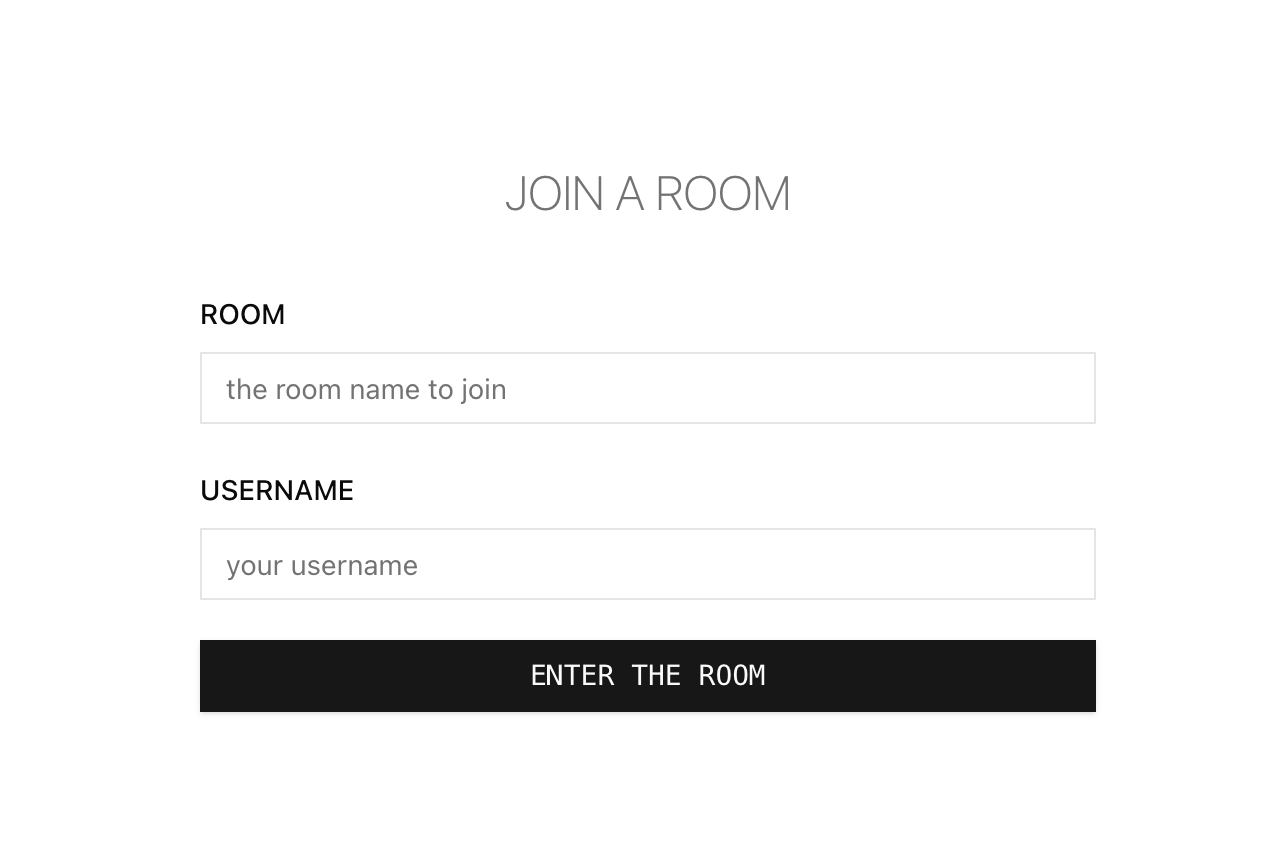Enter Room page
Learn how to set up the Enter Room page on Next.js
In this guide, we will walk through the process of building the Enter Room page:

This page allows users to define the room they wish to join and set their username. Let's build it step by step.
Prerequisites
Before you begin, ensure that you have completed the frontend installation guide, up to the "Set up the Enter Room page" step.
Step by step
To set up the Enter Room page in your Next.js project, follow these steps:
Define the page component
Replace the contents of the file app/page.tsx with the following content:
import { Home } from "@/components/home/home";
export default function HomePage() {
return <Home />;
}Install the UI building block components
Set up the necessary Shadcn/UI components for the Enter Room page.
We will be using the Shadcn/UI CLI to install the UI components. Accept all the defaults from the CLI options.
In the root directory of your project, follow these steps:
Define the base styles
Now, let's tune up a little bit the styling of the Enter Room page.
On the app/globals.css file, replace the @layer base directive configuration with:
@layer base {
* {
@apply border-border outline-ring/50;
}
html {
@apply w-full h-full outline-transparent;
}
body {
@apply w-full h-full outline-transparent bg-background text-foreground;
}
}Set up the page React component
Create a home folder on the components folder.
Home component
On the components/home folder, create a file named home.tsx with the following content:
"use client";
import React from "react";
import LoginForm from "./login-form";
export const Home = () => {
return (
<>
<main className="w-full h-full">
<section
className="relative flex h-full w-full flex-col items-center justify-center p-6"
>
<h3 className="text-2xl font-noto-sans-mono font-extralight text-muted-foreground uppercase mb-8">
Join a Room
</h3>
<LoginForm />
</section>
</main>
</>
);
};LoginForm component
On the components/home folder, create a file named login-form.tsx with the following content:
"use client";
import React from "react";
import { useRouter } from "next/navigation";
import { z } from "zod";
import { zodResolver } from "@hookform/resolvers/zod";
import { useForm } from "react-hook-form";
import {
Form,
FormControl,
FormField,
FormItem,
FormLabel,
FormMessage,
} from "@/components/ui/form";
import { Input } from "@/components/ui/input";
import { Button } from "@/components/ui/button";
import { useCollaborationRoom } from "@/store/store";
const formSchema = z
.object({
username: z
.string()
.trim()
.min(1, { message: "The username is required" })
.max(50, { message: "The username must be maximum 50 characters long" }),
roomId: z
.string()
.trim()
.min(1, { message: "The room name is required" })
.max(50, { message: "The room name must be maximum 50 characters long" }),
})
.required();
function LoginForm() {
const router = useRouter();
const setRoom = useCollaborationRoom((state) => state.setRoom);
const setUser = useCollaborationRoom((state) => state.setUser);
const form = useForm<z.infer<typeof formSchema>>({
resolver: zodResolver(formSchema),
defaultValues: {
username: "",
roomId: "",
},
});
function onSubmit(values: z.infer<typeof formSchema>) {
setRoom(values.roomId);
setUser({
name: values.username,
email: `${values.username}@weavejs.com`,
});
router.push(`/room/${values.roomId}?userName=${values.username}`);
}
return (
<div
className="w-full max-w-md"
>
<Form {...form}>
<form
onSubmit={form.handleSubmit(onSubmit)}
className="w-full space-y-5"
>
<FormField
control={form.control}
name="roomId"
render={({ field }) => (
<FormItem>
<FormLabel className="font-noto-sans-mono">ROOM</FormLabel>
<FormControl>
<Input
placeholder="the room name to join"
className="font-noto-sans-mono rounded-none shadow-none"
{...field}
/>
</FormControl>
<FormMessage />
</FormItem>
)}
/>
<FormField
control={form.control}
name="username"
render={({ field }) => (
<FormItem>
<FormLabel className="font-noto-sans-mono">USERNAME</FormLabel>
<FormControl>
<Input
placeholder="your username"
className="font-noto-sans-mono rounded-none shadow-none"
{...field}
/>
</FormControl>
<FormMessage />
</FormItem>
)}
/>
<Button
type="submit"
className="w-full cursor-pointer font-mono rounded-none"
>
ENTER THE ROOM
</Button>
</form>
</Form>
</div>
);
}
export default LoginForm;Run the project
Once the Enter Room page setup is complete, run the project by executing the following command:
npm run devNavigate to http://localhost:3000 on a browser. You should see the following:

Next steps
Let's now set up the Room page of the Next.js application.
